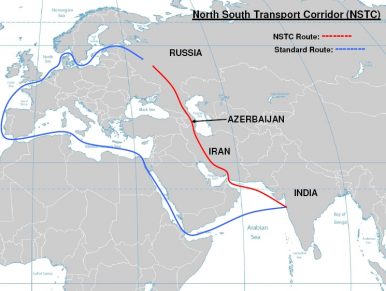By Martand Jha
 After 17 long years, since the inception of the International North-South Transport Corridor (INSTC) agreement between India, Iran, and Russia, the first consignment of goods is ready to be transported from Mumbai to St. Petersburg during mid-January 2018. The regular transport of the goods would start a few months later. The ambitious INSTC project was conceived way back in September 2000 and later came into force in the year 2002 after being ratified by the three countries. Since then, 11 more nations joined the project: Armenia, Azerbaijan, Belarus, Bulgaria (observer status), Kazakhstan, Kyrgyzstan, Oman, Syria, Tajikistan, Turkey, and Ukraine.
After 17 long years, since the inception of the International North-South Transport Corridor (INSTC) agreement between India, Iran, and Russia, the first consignment of goods is ready to be transported from Mumbai to St. Petersburg during mid-January 2018. The regular transport of the goods would start a few months later. The ambitious INSTC project was conceived way back in September 2000 and later came into force in the year 2002 after being ratified by the three countries. Since then, 11 more nations joined the project: Armenia, Azerbaijan, Belarus, Bulgaria (observer status), Kazakhstan, Kyrgyzstan, Oman, Syria, Tajikistan, Turkey, and Ukraine.
Once fully operationalized, INSTC will cut down the transportation costs of goods as well the transportation time. While it currently takes more than 40 days for goods to travel from India to Russia, after the opening of INSTC, transportation would be completed in less than 25 days, thereby cutting down transportation time by 30-40 percent.
It is estimated that the corridor will facilitate carrying 20-30 million tonnes of goods per year. This will boost India’s economy, with Indian exports are expected to increase substantially during the next calendar year. Private companies, which till now have been overlooking Central Asia as a prospective market for their goods, would be looking to invest more in the region.
INSTC will help India to gain smooth access into Central Asia and beyond. With a hostile neighbor like Pakistan, which is situated between India and the Central Asian region, previously India was unable to extend its reach to Central Asia. No longer will Pakistan be an obstacle for India in this regard
Under India’s Connect Central Asia policy, the Central Asian region has already been given a lot of prominence. With the operationalization of INSTC, India-Central Asia relationship will only strengthen. The Central Asian region is part of India’s “extended neighborhood” and of great geostrategic value to India, especially as New Delhi is trying to balance China’s huge presence in the region. The importance of INSTC in expanding India’s trade and investment links with Central Asia has been highlighted in The Foreign Trade Policy of India, 2015-20 as well, signifying the importance India attaches to this region.
In addition, India-Russia trade relations will also get new energy with the help of INSTC. Russia has been India’s long-standing ally but Moscow’s recent inclinations toward Pakistan has raised the eyebrows of many Indian foreign policy analysts. With INSTC, the friendship between India and Russia is expected to grow stronger.
The INSTC is also being seen as New Delhi’s answer to China’s Belt and Road Initiative (BRI). China is not only India’s most powerful neighbor in the region but its competitor as well in the economic arena. India’s ambition to balance China will gain some traction with INSTC’s operationalization.
To sum up, the International North-South Transport Corridor is going to leave a deep impact on India’s engagement with Eurasia and the Central Asian region both geoeconomically and geostrategically, as India looks forward to foster deeper and stronger ties in both regions.
Martand Jha is a junior research fellow at the School of International Studies, Jawaharlal Nehru University, New Delhi.
No comments:
Post a Comment